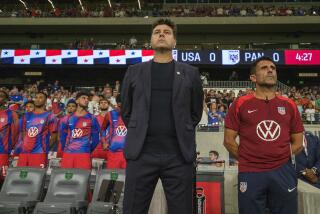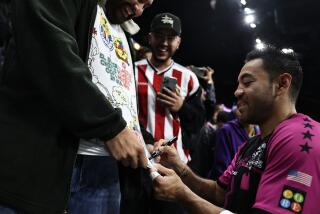U.S. Soccer Team’s Marcelo Balboa Would Be Famous Anywhere Else
Were it not for the professional sport he chose to play, Marcelo Balboa might be a national hero by now.
A sweeper on the U.S. national soccer team, the 6-foot-1, 170-pound Balboa is “an incredible defender,” according to teammate Eric Wynalda.
Balboa can score, too, as he proved last Saturday at the Rose Bowl with the game-winning goal against Trinidad and Tobago in the final minutes of play in the opening round of the Gold Cup, an international tournament that concludes this weekend at the Coliseum.
Nevertheless, futbol, the largest participatory sport in the world, is not likely to make the tall, handsome Cerritos High graduate a household name in this country.
“Marcelo has a big future . . . in Europe or South America or Mexico, wherever he wants to go,” said U.S. assistant coach John Kowalski, who is staying with the team in Torrance and practicing at Cal State Dominguez Hills during the Gold Cup.
Coach Bora Milutinovic, hired in March to mold the U.S. team into a World Cup contender by 1994, calls Balboa “an excellent person.”
“He is a good player, with very good technique,” Milutinovic said. “He is a great ballhandler, especially with his right foot.”
Soccer played a large role in the tightly knit Balboa family. Marcelo’s father, Louis, played professionally in his native Argentina and in the mid-1960s for the Chicago Mustangs of the defunct North American Soccer League.
When Marcelo was 6 months old, Louis Balboa and his wife, Alicia, moved the family from the Midwest to Costa Mesa and then to Lakewood, where Louis coached youth soccer.
Although Marcelo and his older brother, Claudio, also played basketball, baseball and American football, it was soccer talk that made the rounds at the dinner table each evening.
Early on it was Claudio, 25, a midfielder now playing in the semiprofessional Greater Los Angeles Soccer League at Daniels Field in San Pedro, who demonstrated superior soccer skills.
“They were two different types of athletes when it came to soccer,” Louis Balboa said. “Claudio had a stronger leg than Marcelo, but Marcelo was very aggressive.
“Claudio had better skills than Marcelo,” he said, “but Marcelo was a much harder worker.”
Louis suggested to Claudio that he had a better future as a kicker in American football. In 1983 and 1984 Claudio kicked for the football team at Cerritos High. He also played soccer there.
In 1985 he kicked nine field goals and 29 points after touchdowns for the football team at Cerritos College. He also played water polo and soccer, according to a college spokesman. But in the spring of 1986, according to Louis, Claudio turned down several scholarship offers for football and got married.
Said Louis: “It was his decision, and I am very proud of him. Marcelo wanted to continue his career in soccer.”
The brothers are still close. One of Marcelo’s greatest laments is that he has been away from home so long playing soccer that he has yet to meet his new niece, Claudio’s daughter Britany, who was born a month ago.
It was the selection of Marcelo, who is single, to the U.S. under-20 soccer team in 1985, when he was 17, that set the course he wanted.
“Everything started to happen for me in soccer after that,” he said.
In 1987 he was named captain of the under-20 team, which competed in the World Youth Championship tournament. A year later, he was chosen to play on the U.S. Olympic Team. Last summer he started two of three World Cup games for the United States in Italy.
Balboa also played soccer at San Diego State. And he is under contract to the San Francisco Bay Blackhawks of the American Professional Soccer League when he is not touring with the national team.
Barring injury, Balboa is thought to have already secured a spot on the 1994 U.S. World Cup team.
Milutinovic, who is experimenting with about 60 players, has said he won’t make the final cut until sometime in 1993. However, said Kowalski, Balboa “is a clutch player who is starting to do some big things for us. . . . He has a strong shot and a lot of composure in key situations.”
The sweeper is often the last defensive player in front of the goalie. He must make snap judgments on positioning.
When the sweeper’s team is attacking, minutes go by when he has no opportunity to tackle the ball. But he has a view of the entire field and must keep alert to prevent counterattacks from building.
Against Trinidad and Tobago, for instance, Balboa turned back four counterattacks by heading the ball at least 20 yards back into the attacking area for the United States.
It can be a frustrating position to play.
In the closing moments of a 3-0 victory last Monday against Guatemala, Balboa was caught off guard by a long pass into the attacking area. He collided with a Guatemalan player just outside the penalty area. Although television replays showed that the foul appeared to be unintentional, Balboa was whistled by the referee for a “professional” foul and ejected. By international rules, he had to sit out Wednesday night’s game at the Coliseum with Costa Rica.
Sweepers sometimes become attackers, too, although they aren’t expected to score a lot. This part of his game has set Balboa apart from most other defenders in the country.
Said Wynalda, a forward: “He has the ability to come forward well, and when he picks the right time he can be successful.”
Picking the correct time to attack, as he did in the 2-1 victory over Trinidad and Tobago, is the key, Balboa insists.
That goal, his second in international play, may go down in history as one of the most important goals from a motivational standpoint that a U.S. team has ever scored. It appeared to lift the team’s spirits.
Said Balboa: “That’s what I like. To attack and surprise.”
Balboa, who admits that he is “kind of quiet,” has been criticized for not being talkative on the field or in practice.
“I’m not much for screaming or yelling,” he said. “I just want to be consistent. I have talked to my dad about (talking more on the field), and (goalkeeper) Tony Meola has talked to me about it, so the last few games I have been doing more yelling.”
Wynalda, who often rooms with Balboa on road trips, says Balboa’s quietness is misunderstood.
“He is very professional in the way he goes about things,” Wynalda said. “He is very steady. He shows up and does his job. That’s Marcelo.”
The Spanish-language newspaper La Opinion was critical of Balboa following the Trinidad and Tobago game, saying his defensive mistake (a point Louis Balboa disputes) allowed Trinidad’s Leonson Lewis to score for a 1-0 lead in the 67th minute.
But the newspaper conceded that Balboa’s winning, over-the-shoulder goal, known as a “bicycle kick,” was spectacular.
After that game, in the tunnel that leads to the pitch at the Rose Bowl, Balboa reflected on that shot. Yes, he said, he had chosen the correct moment to go forward.
The victory dash around the field--he was chased, then mobbed, by his teammates--may mark one of the few times in his career that he will celebrate in front of an American audience.
Wearing a red, white and blue team warm-up suit, he told some friends: “Man, I’m telling you, I’ve been waiting for that since I was 8.”






